Treatment for a Cracked Tooth
Whether your tooth cracks from an injury or general wear and tear, you can experience a variety of symptoms ranging from erratic pain when you chew your food to sudden pain when your tooth is exposed to very hot or cold temperatures. In many cases, the pain may come and go and your dentist may have difficulty locating the tooth causing the discomfort. If you experience these symptoms or suspect a cracked tooth, it’s best to see an endodontist as soon as possible.
Endodontists specialize in saving cracked teeth and will cater treatment to the type, location, and extent of the crack. The sooner your tooth is treated, the better the outcome. Once treated, most cracked teeth continue to function as they should, for many years of pain-free biting and chewing.
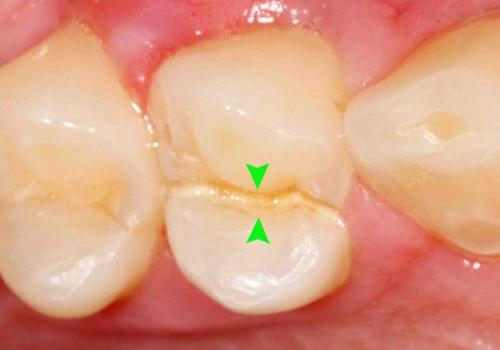
Cracked teeth show a variety of symptoms, including erratic pain when chewing, possibly with the release of biting pressure, or pain when your tooth is exposed to temperature extremes. In many cases, the pain may come and go, and your dentist may have difficulty locating which tooth is causing the discomfort.
There are many different types of cracked teeth. The treatment and outcome for your tooth depend on the type, location, and extent of the crack.
Craze Lines
Craze lines are tiny cracks that affect only the outer enamel. These cracks are extremely common in adult teeth. Craze lines are very shallow, cause no pain, and are of no concern beyond appearances.
Fractured Cusp
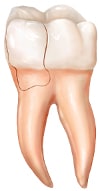 When a piece of a tooth’s chewing surface breaks off, often around a filling, it’s called a fractured cusp. A fractured cusp rarely damages the pulp, and usually doesn’t cause much pain. Your dentist can place a new filling or crown over the damaged tooth to protect it.
When a piece of a tooth’s chewing surface breaks off, often around a filling, it’s called a fractured cusp. A fractured cusp rarely damages the pulp, and usually doesn’t cause much pain. Your dentist can place a new filling or crown over the damaged tooth to protect it.
If you've cracked a tooth and breathing through your mouth or drinking cold fluids is painful, bite on clean, moist gauze or cloth to help relieve symptoms until reaching your dentist’s office. Never use topical oral pain medications (such as Anbesol®) or ointments, or place aspirin on the affected areas to eliminate pain symptoms.
Cracked Tooth
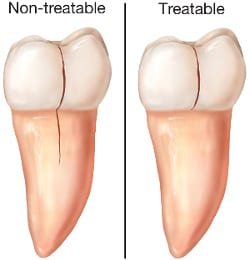 A cracked tooth means a crack extends from the chewing surface of your tooth vertically toward the root. The tooth is not yet separated into pieces, though the crack may gradually spread. Early diagnosis is important in order to save the tooth. If the crack has extended into the pulp, the tooth can be treated with a root canal procedure and a crown to protect the crack from spreading.
A cracked tooth means a crack extends from the chewing surface of your tooth vertically toward the root. The tooth is not yet separated into pieces, though the crack may gradually spread. Early diagnosis is important in order to save the tooth. If the crack has extended into the pulp, the tooth can be treated with a root canal procedure and a crown to protect the crack from spreading.
However, if the crack extends below the gum line, it is no longer treatable, and the tooth cannot be saved and will need to be extracted. That’s why early treatment is so important. A cracked tooth that is not treated will progressively worsen, eventually resulting in the loss of the tooth. Early diagnosis and treatment are essential in saving these teeth.
Split Tooth
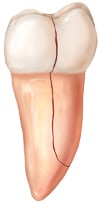 A split tooth is often the result of the long-term progression of a cracked tooth. The split tooth is identified by a crack with distinct segments that can be separated. A split tooth cannot be saved intact. The position and extent of the crack, however, will determine whether any portion of the tooth can be saved. In some cases, endodontic treatment may be performed to save a portion of the tooth.
A split tooth is often the result of the long-term progression of a cracked tooth. The split tooth is identified by a crack with distinct segments that can be separated. A split tooth cannot be saved intact. The position and extent of the crack, however, will determine whether any portion of the tooth can be saved. In some cases, endodontic treatment may be performed to save a portion of the tooth.
Vertical Root Fracture
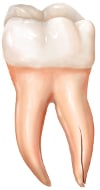 Vertical root fractures are cracks that begin in the root of the tooth and extend toward the chewing surface. They often show minimal signs and symptoms and may, therefore, go unnoticed for some time. Vertical root fractures are often discovered when the surrounding bone and gum become infected. Treatment may involve extraction of the tooth. However, endodontic surgery is sometimes appropriate if a tooth can be saved by removal of the fractured portion.
Vertical root fractures are cracks that begin in the root of the tooth and extend toward the chewing surface. They often show minimal signs and symptoms and may, therefore, go unnoticed for some time. Vertical root fractures are often discovered when the surrounding bone and gum become infected. Treatment may involve extraction of the tooth. However, endodontic surgery is sometimes appropriate if a tooth can be saved by removal of the fractured portion.

